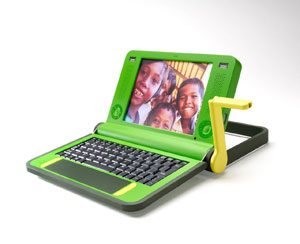 Jerome Woody writes about green computing. That raises the question: What would it take to make computers truly sustainable?
Jerome Woody writes about green computing. That raises the question: What would it take to make computers truly sustainable?
The first thing to note is that while we do need to consider the energy computers use in operation, it is dwarfed by what it takes to make them in the first place. Back in 2004, Eric Williams estimated that more than 80 percent of the energy a computer will use during its lifetime is consumed during manufacture [1]. To gain perspective on the total impact of computer manufacture (rather than just greenhouse emissions): the fossil fuels burned and water polluted during manufacture of a computer system typically weigh more than an SUV.
How do we reduce this?
There is some good news. Many of the right things to do in terms of operating energy also reduce manufacturing energy. For example, LCD monitors not only consume less energy in operation than CRTs, they also require less energy to manufacture [2]. In general, the same laptops that use less energy in operation than desktops also use less during manufacture. So the Z1 unit mentioned in Jerome’s post, which is a very laptop-like little server, almost certainly is greener than your average server on a lifecycle assessment, not just in operation.
The trend is that laptops are replacing desktops as standard computers, and the desktops that remain are growing more laptop-like. The bad news is that even switching to an all laptop standard would not reduce computer impact by as much as we need. The good news is that what we do need to do is simple, straightforward, and for the most part comparatively inexpensive. Green computing will cost more than brown computing, but not a lot more.
For example, in manufacturing LCD monitors, one of the major greenhouse gas impacts is sulfur hexafluoride, a greenhouse gas with impacts many thousands of times greater than CO2. In the long run, we will want to find substitutes that let us phase this out completely. In the meantime, it is comparatively easy to greatly reduce its use, and to capture and recycle what we do use, lowering that particular impact by 90% or more [3].
As another example, water and chemical use in chip making may be reduced 80-95 percent through techniques ranging from simple things like extending the length of soaks in cleaning baths, to using dry processes and clean chambers to reduce the need for water and chemicals, to improved purification and recycling of used water and chemicals [4].
Similarly, circuit boards may be silk-screened rather than etched, using fewer harsh chemicals and less water to produce a lead-, halogen-, and bromide-free result, along with less manufacturing waste [5].
In chip packaging (attaching chips to boards), epoxies and films can replace lead solders, greatly reducing both toxicity and energy use.
Case manufacture and computer assembly can be done in more environmentally friendly ways too, by using greener plastics, and lead- and bromide-free solders, or solder substitutes.
Lastly, we can achieve a great deal by extending computer lifespans. I doubt the predictions of an average two-year lifespan for computers ever quite came true, but there is no doubt that we throw away our computers awfully soon. Make computers with easier to open cases, and roomier bays. (Dell and many other manufacturers already do this.) Limit software license restrictions that forbid selling obsolete computers with old, obsolete software. That will encourage “second lives” for business computers that are currently scrapped to avoid copyright liabilities.
Make manufacturers liable for recycling computers at the end of their lives (as in Europe). This will encourage both longer lifespans and easier-to-recycle computers.
Though I’ve placed it last, increasing computer lifespan may be the single most important way to lower manufacturing impact.
—–
[1] Williams, Eric. “Energy Intensity of Computer Manufacturing: Hybrid Assessment Combining Process and Economic Input-Output Methods” (PDF). Environmental Science & Technology Vol. 38, No. 22 11/15/04, American Chemical Society, 09/18/2005. Full version (subscription required).
[2] Overly, Jonathan G., Lori E. Kincaid, and Jack R. Geibig, “Chapter 3: Lifecyle Impact Assessment,” Desktop Computer Displays: A Life-Cycle Assessment, EPA-744-R-01-004a. 12/01. Environmental Protection Agency, 03/18/05.
[3] Carson, Richard T. and Nadja Marinova. “Running on Air,” 09/99. Institute on Global Conflict and Cooperation IGCC Policy Briefs. Policy Brief Number 13, 02/21 2005. Institute on Global Conflict and Cooperation (IGCC), 03/18/05.
[4] Pacific Northwest Pollution Prevention Resource Center, “Topical Reports: Energy and Water Efficiency for Semiconductor Manufacturing,” Pollution Prevention (P2) Pays: N.C. Division of Pollution Prevention and Environmental Assistance, 02/00, Pacific Northwest Pollution Prevention Resource Center, 09/17/05.
Wakamatsu, Hidetoshi; Akira Mayuzumi; and Norio Tanaka, “Effective Utilization Technology for Ultra Pure Water, Chemical Liquids and Waste Materials on Semiconductor Manufacturing Plant” (PDF). OKI Technical Review 68, No. 188. Special Edition on the Environment, 12/01. Oki Industry Co. Ltd, Environment Division, 05/23/04.
Stanford University News Service, “Can Computer Chip Makers Reduce Environmental Impact?” 06/05/96.
[5] EECO: A Transico Company, “EECO-Greenä Silver-through-hole Double-sided Printed Circuit Board Product Overview Design Consideration FAQ’s” (PDF), 12/03. EECO: A Transico Company, 05/22/04.
 Jerome Woody writes about
Jerome Woody writes about 

